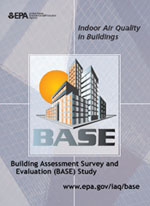Building Assessment Survey and Evaluation Study

CD Version of the Building Assessment Survey and Evaluation Study: EPA 402-C-06-002, January 2006
Do You Work in an Office?
Good indoor air quality depends on the actions of everyone in the building. Learn more about what you can do.
- Basic Information and Overview: This section provides a basic description of the study, its goals and objectives and the information collected, the Base Regional Map and how to get the data.
- Methodology: The BASE study was conducted using a standardized protocol. A description of the seven basic activities performed for each of the study buildings is provided.
- Summarized Data: Summaries of select information collected from the one hundred BASE buildings studied are available here.
- Highlighted Analysis: The data collected provide normative information on several parameters which can be used for further assessment and analysis of IAQ-related issues. Summaries and results of assessments and analyses performed on the BASE data is highlighted.
- Publications: The protocol, quality assurance plan and other supporting study documentation as well as publications describing the study and summarizing select study results are available here.
- How to Obtain Data: A CD-ROM can be ordered which contains data collected during the BASE Study. It contains the same data files in two different formats (SAS® and dBASE®). The CD-ROM also contains the BASE Study Data User's Guide, Data Dictionary and several additional files.
- Frequent Questions: We have provided answers to what we consider some of the probable frequently asked questions regarding this study.
Millions of people spend a majority of their working hours in office environments. Indoor air quality (IAQ) can significantly impact the health, productivity and sense of well being of building occupants. Poor indoor air is estimated to cost the nation tens of billions of dollars each year in lost productivity and countless hours of illness and discomfort.
Early research concerning IAQ in the U.S. public and commercial office buildings focused on evaluating buildings whose occupants had significant public health complaints. Since baseline information from typical buildings was sparse, no reference existed with which to compare the so-called "sick" buildings. To fill this data gap, EPA conducted the Building Assessment Survey and Evaluation (BASE) Study, a cross-sectional study of public and commercial office buildings across the U.S. The information collected in this study provides normative IAQ data and symptom incidence in typical office buildings.
The BASE Study covers three major areas:
- Environmental and comfort measurements,
- Building and heating, ventilation and air-conditioning (HVAC) systems characterization
- Building occupant demographics, symptoms and perceptions.
Indoor air quality data from 100 randomly selected public and commercial office buildings were collected using a standardized protocol. Buildings were selected from 10 climatic regions in 37 cities and 25 states.
The data can be used to examine the relationships among environmental measures, building characteristics and occupant perceptions. In addition, the data may be used to generate hypotheses on topics such as sick building syndrome.
Scientists and policy makers may also use the data to develop or refine guidance and policy on the design, construction, operation and maintenance of buildings. In addition, the standardized protocol, established to collect BASE data, may be useful for future IAQ benchmarking studies.
